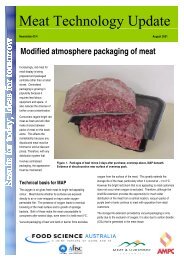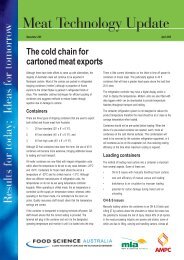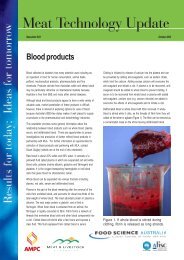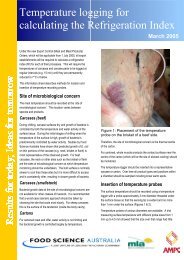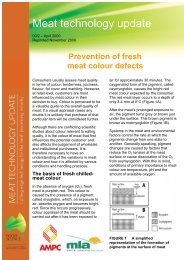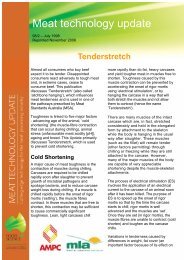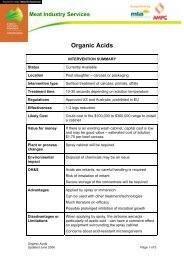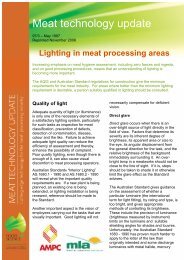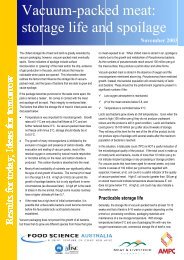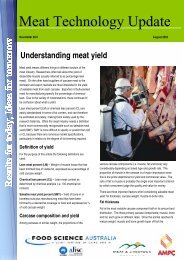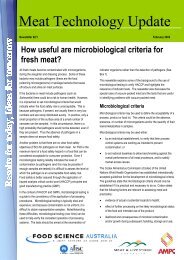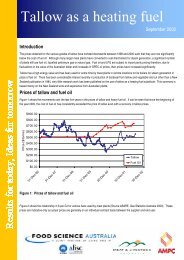Storage life of meat - Mulwarra Exports
Storage life of meat - Mulwarra Exports
Storage life of meat - Mulwarra Exports
You also want an ePaper? Increase the reach of your titles
YUMPU automatically turns print PDFs into web optimized ePapers that Google loves.
Frozen <strong>Storage</strong>During frozen storage microbiological growth is arrested, but <strong>meat</strong> will slowly deteriorate due to oxidative and other changes. Frozenstorage <strong>life</strong> is normally limited by the development <strong>of</strong> adverse flavours caused by oxidative rancidity <strong>of</strong> fat. The temperature <strong>of</strong> storage,method <strong>of</strong> packaging and degree <strong>of</strong> saturation <strong>of</strong> the fat all affect the onset <strong>of</strong> these changes. The effect <strong>of</strong> temperature is evident inTable 2. Meat from ruminants (saturated fats) is generally more stable with respect to oxidative changes than <strong>meat</strong> from non-ruminants,such as pork. There is also evidence that a longer chilled storage time before freezing will reduce the frozen storage <strong>life</strong> - for instance, ifchilled <strong>meat</strong> has been aged in vacuum packs and then frozen. The frozen storage <strong>life</strong> may also be reduced if the product iscomminuted, because this process exposes more <strong>meat</strong> surfaces to air.Some people are more sensitive to alterations in flavour than others, so practical storage periods for frozen <strong>meat</strong> may depend on themarket destination and the end specific use for the product. The data in Table 2 are based on information from consumer panels tastingboiled, roasted or grilled samples.Table 2. Practical storage <strong>life</strong> (months) <strong>of</strong> some frozen <strong>meat</strong> productsProduct -12ºC -18ºC -24ºC ReferenceBeef (stockinette) 12 18 24 7, 8Lamb & mutton (wrapped) 8 16 18 7, 8Veal (wrapped) 4 14 8 7Ground beef (wrapped) 4 6 8 7Beef steaks (vac. packed) 8 18 24 8Lamb chops (wrapped) 12 18 24 8Liver 4 12 18 8Cooked <strong>meat</strong>s 3 4 7Retail DisplayThe retail display <strong>life</strong> <strong>of</strong> consumer portions <strong>of</strong> <strong>meat</strong> is normally limited by colour changes. Brown discolouration <strong>of</strong> fresh <strong>meat</strong> (due t<strong>of</strong>ormation <strong>of</strong> metmyoglobin) normally occurs before unacceptable bacterial growth has occurred. The onset <strong>of</strong> discolouration occursmore rapidly at higher temperatures, and also in <strong>meat</strong> that has been stored for extended periods in vacuum packs. Modified atmospherepackaging (MAP) in an atmosphere high in oxygen will extend display <strong>life</strong>. For a more detailed discussion <strong>of</strong> MAP <strong>meat</strong>, please refer toMeat Technology Update newsletter 01/4.Table 3 shows retail display <strong>life</strong> (in days) at about 5ºC <strong>of</strong> packaged <strong>meat</strong>s, some <strong>of</strong> which has been stored for various periods in vacuumpacks at 0ºC.Table 3. Retail display <strong>life</strong> (in days) at about 5ºC <strong>of</strong> packaged <strong>meat</strong>s after storage in vacuum packs at 0°CProductDisplay packaging typeTime stored in vacuum packs (at 0°C)(at 5°C) 0 weeks 2 weeks 4 weeks 6 weeks 8 weeksReferenceBeef retail cuts Overwrapped 3 3 2 2 1 4Beef retail cuts 80% O2, 20% CO2 MAP >7 5 – 6 4 – 5 3 – 4 2 4Lamb cuts Overwrapped 3 3 2 1 – 2 1 9Beef patties 100% CO2 MAP 7 10Ground beef Overwrapped 1 2Ground beef 80% O2, 20% CO2 MAP 3 – 5 2Sliced corned beef Vacuum-packed 14 4
References1. Bem Z, Hechelmann, H. (1995) Chilling and refrigeratedstorage <strong>of</strong> <strong>meat</strong>. Fleischwirtshaft, 75: 439-44.2. International Institute <strong>of</strong> Refrigeration (2000)Recommendations for chilled storage <strong>of</strong> perishableproduce.3. Kelly C. A., Lynch B., McLaughlin A. J. (1982) The effect<strong>of</strong> spray washing on the development <strong>of</strong> bacterialnumbers and storage <strong>life</strong> <strong>of</strong> lamb carcases. Journal <strong>of</strong>Applied Bacteriology, 53: 335-41.4. Egan, A. F., Eustace, I. J., Shay, B. J. (1988) Meatpackaging – maintaining the quality and prolonging thestorage <strong>life</strong> <strong>of</strong> chilled beef, pork and lamb. Proceedings <strong>of</strong>Meat 88.5. Johnson, B. Y. (1991) Weep and other characteristics <strong>of</strong>chilled <strong>meat</strong>. In: The production <strong>of</strong> chilled <strong>meat</strong> for export– workshop proceedings, CSIRO Division <strong>of</strong> Food Processing,Brisbane.6. Gill C. O., Penney N. (1985) Modification <strong>of</strong> in-pack conditionsto extend the storage <strong>life</strong> <strong>of</strong> vacuum packaged lamb. MeatScience 14: 43-60.7. ASHRAE - Refrigeration systems and applications handbook(2002). Meat products, Pg 16. www.ashrae.org8. International Institute <strong>of</strong> Refrigeration. Recommendations forthe processing and handling <strong>of</strong> frozen foods. 3 rd Ed, 1986.9. Bill B. A., Eustace, I. J., Smith, D. R. (1988) <strong>Storage</strong> <strong>life</strong> <strong>of</strong>chilled primal cuts <strong>of</strong> lamb. CSIRO Meat Research Report3/88.10. Bentley D. S., Reagan, J. O., Miller, M. F. (1989) Effects <strong>of</strong> gasatmosphere, storage temperature and storage time on shelf-<strong>life</strong>and sensory attributes <strong>of</strong> vacuum packaged ground beefpatties. Journal <strong>of</strong> Food Science, 54: :284-86.



